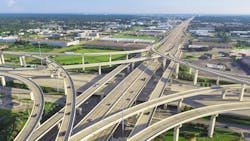Texas Infrastructure Receives Overall C Grade
On Tuesday, the American Society of Civil Engineers (ASCE) revealed Texas has received an overall grade of a “C” in its 2025 Texas Infrastructure Report Card.
The report card that has 16 different categories, including road infrastructure, serves as a tool that can be used by lawmakers in its legislative session to help use tax dollars more efficiently.
This is the same overall grade Texas received in the 2021 report, with the ASCE citing “significant population growth, surging energy demands and increasingly severe weather events” putting strain on an aging infrastructure network.
An influx of funding from the federal Infrastructure Investment and Jobs Act (IIJA) and state and local initiatives have helped improve or maintain conditions in the transportation sector, with roads receiving a higher grade of a C- compared to 2021 and bridges—one of the state’s highest performing categories—received a B-.
Austin Messerli P.E., co-chair, Texas Infrastructure Report Card Committee, ASCE Texas Section, spoke to the report card’s importance.
“The Texas Infrastructure Report Card not only helps us recognize the progress we’ve made, but it also serves as a call to action. By investing in and improving our infrastructure today, we are laying the groundwork for a stronger, more resilient future that will benefit future generations.”
Still, only 1.2% of bridges are listed as being in poor condition in the state, which is the third lowest rate in the nation. Texas’ 56,000 bridges, twice the number of any other state, carry approximately 616 million vehicles per day, “underscore[ing] the necessity of these three sectors to be performing adequately if Texas wishes to sustain its population and economic growth and promote public safety” according to the ASCE.
The ASCE made the following recommendations for Texas to improve its grades:
- Continue investments in Texas infrastructure by appropriating funding and revenues to their respective source, injecting funding through grant programs and low interest loans, adopting appropriate fees with periodic review for rate adjustments and by investing in research and advancement of technology for efficiency.
- Drive sound policy and standards that ensure safety, efficiency and reliability for projects across all categories.
- Continue reviews and modernization of engineering standards that incorporate innovation and resilience to minimize risks and vulnerabilities to our infrastructure networks.
- Prioritize asset management and planning, which allows owners to plan, manage, optimize investments and allocate resources effectively
Source: News4SA, American Society of Civil Engineers
